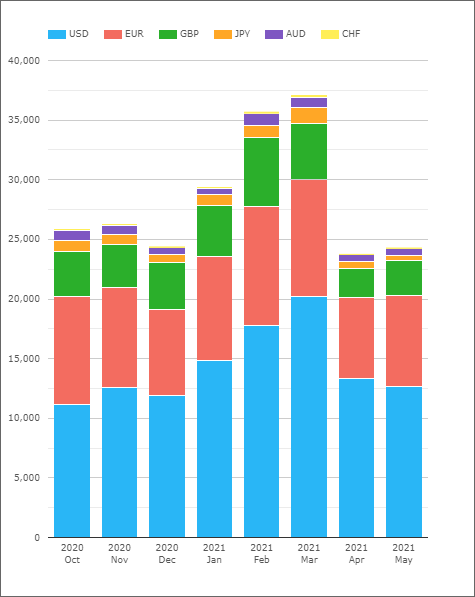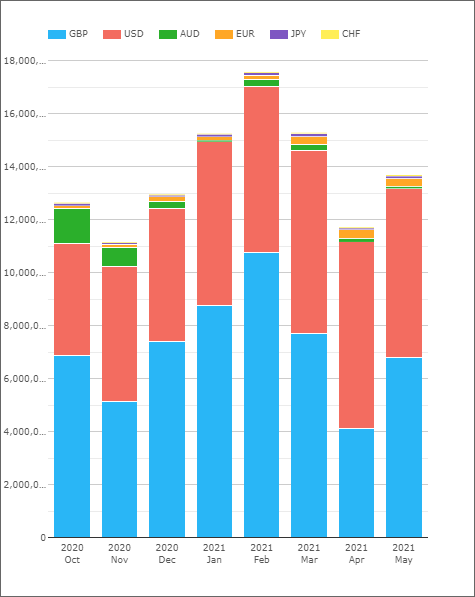The latest ISDA-Clarus RFR Adoption Indicator has been published for May 2021. It saw an increase to 10.7%, a small increase from last month. When will the big leaps happen?

Showing;
- The RFR Adoption Indicator was at 10.7%. This was higher than last month and very similar to all of the 2021 readings (March aside).
- USD SOFR decreased to 6.9%, the third highest reading we’ve ever seen.
- $6.4Trn of SOFR-linked notional traded in USD. In notional terms, SOFR was the second largest RFR market last month, after SONIA.
- CHF SARON trading dropped back down to 13.7% of the overall CHF Rates market. This makes CHF the second most adopted RFR market (after SONIA) when measured by percentage uptake.
- 55% of GBP risk was traded versus SONIA, a new all-time high.
- 6.8% of JPY risk was traded versus TONA, a new all-time high.
Behind the Data
Digging into CCPView for the actual DV01 data, May 2021 was still a relatively subdued month in terms of overall trading activity:

Showing;
- Total DV01 traded across IBORs and RFRs in six major currencies. This covers both OTC Swaps and exchange traded futures.
- May activity saw volumes recover somewhat, but still below Q1 2021 activity levels.
The amount of activity in most currencies was stable between April and May 2021. However, the amount of SONIA risk traded increased by 19% month-on-month. This was a key component in helping to move the RFR adoption indicator higher this month.
Which is Bigger – SONIA or SOFR?
RFR markets continue to be characterised by the huge size of SONIA and SOFR compared to everything else. Yes, SONIA retook the crown as largest RFR market last month (as measured by both Notional and/or DV01), but the size of the SOFR market should not be underestimated. It just so happens the overall size of the USD Rates market is so big of course!

Showing;
- $6.8Trn vs $6.4Trn notional equivalent traded in SONIA and SOFR-linked products respectively in May 2021.
- Comparing to May 2020, the amount of SOFR risk traded increased by 2.4 times, and SONIA increased by 1.5 times.
- That is some impressive growth in SOFR!
What is Happening in JPY?
Our particularly eagle-eyed readers may have noticed a heartbeat in the hitherto quiet JPY TONA market. The adoption indicator improved to 6.8% here, a record high that seemingly came from nowhere. Recall we were stuck at just 3.9% last month!

However, we should not put too much of a positive slant on this reading. Activity in JPY Rates markets was VERY subdued last month, dropping to the lowest total risk traded that we have seen on record. This may just be a consequence of subdued trading conditions, but is certainly something to keep an eye on. Certainly, TONA did not hit any records in terms of the absolute amount of risk traded. You can read more about the possibility of a multiple-rate approach for JPY Rates in our blog from last week:
In Summary
- The ISDA-Clarus RFR Adoption Indicator increased to 10.7% in May 2021.
- This was mainly driven by a recovery in GBP SONIA volumes from last month.
- SOFR was the second largest RFR market in May 2021 when measured by absolute notional or by DV01.
- CHF SARON risk reached 13.7% of the overall CHF market, making it the second “most adopted” RFR.
- A headline jump to 6.8% for JPY markets is positive for TONA, but overall activity was very subdued.

Including EUR distorts the picture in the top level number given there is no move away form EURIBOR. Other than that keep up the good work! Thanks